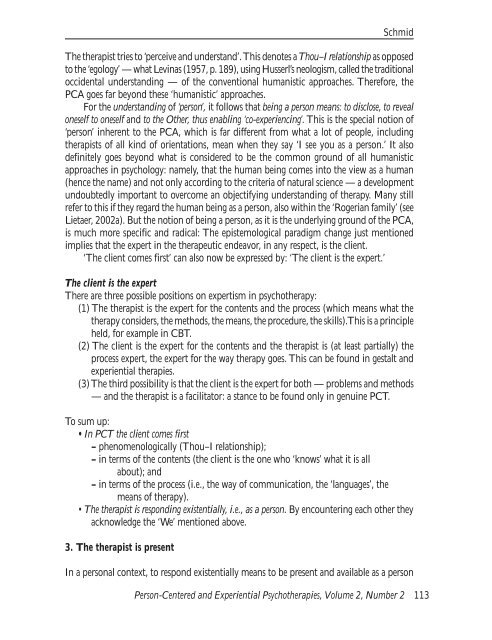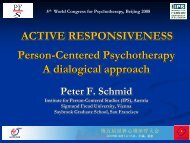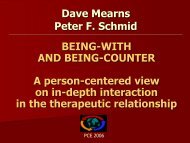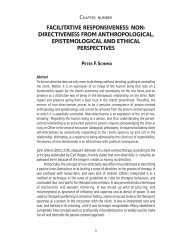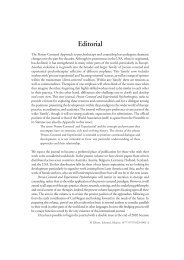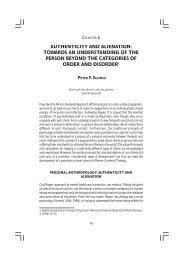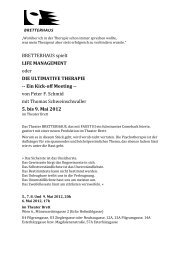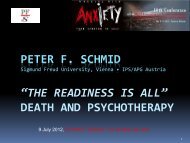The Characteristics of a Person-Centered ... - Peter F. Schmid
The Characteristics of a Person-Centered ... - Peter F. Schmid
The Characteristics of a Person-Centered ... - Peter F. Schmid
- No tags were found...
You also want an ePaper? Increase the reach of your titles
YUMPU automatically turns print PDFs into web optimized ePapers that Google loves.
<strong>Schmid</strong><strong>The</strong> therapist tries to ‘perceive and understand’. This denotes a Thou–I relationship as opposedto the ‘egology’ — what Levinas (1957, p. 189), using Husserl’s neologism, called the traditionaloccidental understanding — <strong>of</strong> the conventional humanistic approaches. <strong>The</strong>refore, thePCA goes far beyond these ‘humanistic’ approaches.For the understanding <strong>of</strong> ‘person’, it follows that being a person means: to disclose, to revealoneself to oneself and to the Other, thus enabling ‘co-experiencing’. This is the special notion <strong>of</strong>‘person’ inherent to the PCA, which is far different from what a lot <strong>of</strong> people, includingtherapists <strong>of</strong> all kind <strong>of</strong> orientations, mean when they say ‘I see you as a person.’ It alsodefinitely goes beyond what is considered to be the common ground <strong>of</strong> all humanisticapproaches in psychology: namely, that the human being comes into the view as a human(hence the name) and not only according to the criteria <strong>of</strong> natural science — a developmentundoubtedly important to overcome an objectifying understanding <strong>of</strong> therapy. Many stillrefer to this if they regard the human being as a person, also within the ‘Rogerian family’ (seeLietaer, 2002a). But the notion <strong>of</strong> being a person, as it is the underlying ground <strong>of</strong> the PCA,is much more specific and radical: <strong>The</strong> epistemological paradigm change just mentionedimplies that the expert in the therapeutic endeavor, in any respect, is the client.‘<strong>The</strong> client comes first’ can also now be expressed by: ‘<strong>The</strong> client is the expert.’<strong>The</strong> client is the expert<strong>The</strong>re are three possible positions on expertism in psychotherapy:(1) <strong>The</strong> therapist is the expert for the contents and the process (which means what thetherapy considers, the methods, the means, the procedure, the skills).This is a principleheld, for example in CBT.(2) <strong>The</strong> client is the expert for the contents and the therapist is (at least partially) theprocess expert, the expert for the way therapy goes. This can be found in gestalt andexperiential therapies.(3) <strong>The</strong> third possibility is that the client is the expert for both — problems and methods— and the therapist is a facilitator: a stance to be found only in genuine PCT.To sum up:• In PCT the client comes first– phenomenologically (Thou–I relationship);– in terms <strong>of</strong> the contents (the client is the one who ‘knows’ what it is allabout); and– in terms <strong>of</strong> the process (i.e., the way <strong>of</strong> communication, the ‘languages’, themeans <strong>of</strong> therapy).• <strong>The</strong> therapist is responding existentially, i.e., as a person. By encountering each other theyacknowledge the ‘We’ mentioned above.3. <strong>The</strong> therapist is presentIn a personal context, to respond existentially means to be present and available as a person<strong>Person</strong>-<strong>Centered</strong> and Experiential Psychotherapies, Volume 2, Number 2 113


